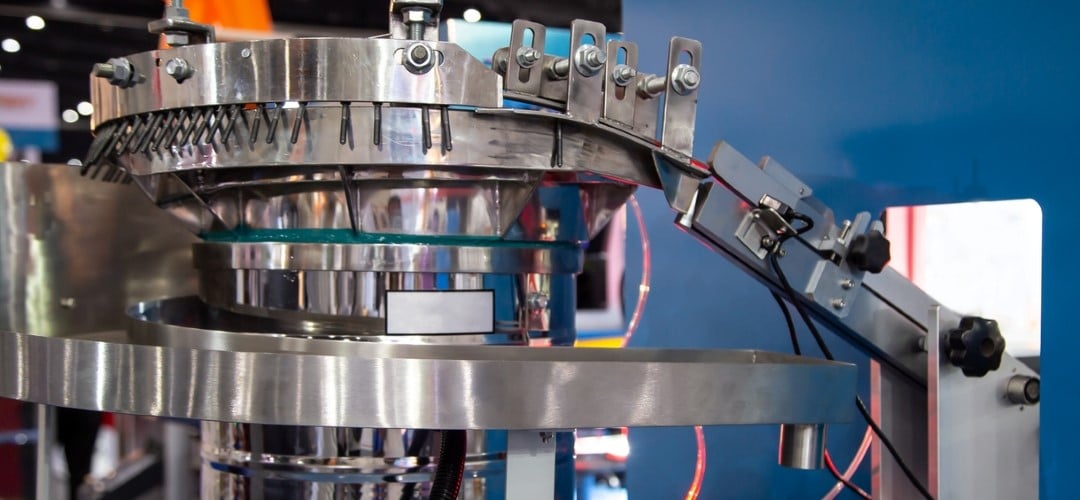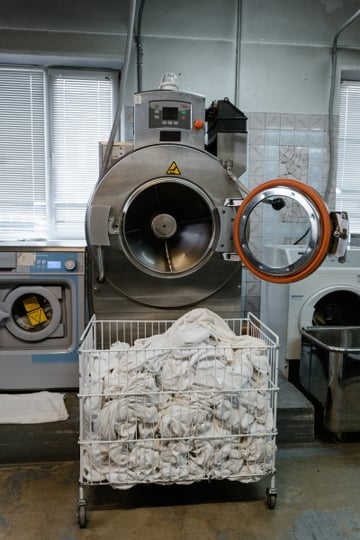Vibrating Machine Structural Foundation Design: Risks & Control Factors

Table of Contents:
The rise of the machines means they’re on the move more than ever.
Often, the design of an industrial machine base or frame (especially in automation lines) involves consideration of both static and, more importantly, dynamic loads. Failure to keep up with cyclic loading has a deeper impact than just routine maintenance.
To help your build fulfill its purpose – “self-efficiency” – review the risks and causes of failure in structure and foundation design for vibrating machines. We’ll focus on machines framed with aluminum extrusion, but also touch on steel – and why you shouldn’t discount aluminum building systems just yet.
5 Dangers of Failed Design in Vibrating Machine Structures & Foundations
The more delicate or mission-critical your application is, the more you need to keep it together – literally.
The obvious risk of a poorly designed structural framing system is loss of stability (and, inevitably, structural failure). Shiny, new machine supports may inspire confidence on Day 1, but if those supports loosen with vibration, they’ll eventually fail if not serviced. An enclosure that doesn’t protect factory workers is useless. A material-handling machine that can’t hold heavy materials is also – you guessed it – useless.
There are four more secondary impacts to this endless Band-Aid approach that you may not realize:
Accuracy
In many automation and lab settings, precision is a must, not a nice-to-have.
If vibration jostles a quality-control sensor out of alignment, it may give bad readings. That could result in your line producing an entire batch of bad results, leaving you with nothing to show for all those production costs.
Another common end result of misaligned sensors is that the operators blame the sensor and not the structural support, and order a replacement for the wrong suspect.
Safety
Obviously, poor structural vibration control is a threat to both humans and nearby equipment.
In machining operations, it’s mind-boggling how many industrial safety enclosures don’t actually offer safety. Too often they lack the sturdiness to back up their bark with bite.
However, in many vibration-susceptible use cases, broken connections aren’t the only safety risk.
Take the sensor example above. If a safety sensor isn’t sensing anything, it’s not warning anyone of potential hazards to nearby people and equipment.
To tighten a loose connection on a high-risk component or safety feature, you typically need to access the inside of the enclosure, which is a hazard in its own right. It’s enclosed for a reason!
Fatigue
Industrial applications often invite chronic stress to the structure’s foundation. This can introduce microscopic cracks that turn into much larger cracks over time.
When the total stress and cracking exceed a component’s fracture toughness, a fracture occurs. This often happens because the designer didn’t specify a material and manufacturing process durable enough for a vibration-heavy application.
Downtime
Frequently stopping machines for accuracy, durability, and safety issues comes with a cost.
The more a device is subject to cyclic loading, the more often someone has to retighten its connections. That usually can’t happen while the line is running.
This is particularly wasteful with automation machinery, which is supposed to be as hands-off as possible. Each issue that requires a human’s intervention is a waste of time and money.
(Related article: How to Reduce Maintenance Downtime for Structural Framing)
 Why Do Vibrating Machine Structures & Foundations Fail Fast?
Why Do Vibrating Machine Structures & Foundations Fail Fast?
To design a better industrial machine, you must understand why some aluminum extrusion framing components fail prematurely.
The fast unfastening of a structure usually comes down to the builder’s use of T-slotted aluminum framing for the base (and perhaps elsewhere).
That’s not to say the material choice is to blame. In machine frames and bases, a lack of engineering is what typically causes T-slot extrusions to falter vs. welded steel frames.
What’s the technical explanation? Two words: pivots and friction.
Every T-slot extrusion profile uses a pinned connection that can pivot.
T-slot structures have a slight downward angle. When you tighten the bolts, they’re supposed to stay secure. However, that’s a flawed philosophy – the force you use to pull it straight is ineffective. You can see the proof when you move the structure.
Once the structure moves (or is moved), the bolt loosens, and the connection relies on friction at that point to stay in place. The profile can easily shift any direction perpendicular to the bolt axis. As a result, a T-slot aluminum extrusion framing system only draws a fraction of the profile’s potential strength.
Fortunately, these issues are correctable with a better structural build. (See the Solutions section below.)
Examples of Structural Design Risks in Vibrating Machinery
Much of the equipment you’d find on an automation line or fabrication workstation is prone to misalignment and loosening. The most blatantly obvious example is a vibratory feeder bowl – the name says it all.
Say you’re producing a lot of small components that a machine must orient in a certain direction for a drilling operation. The vibration will be pervasive throughout operation – a T-slot aluminum framing system will practically need a dedicated maintenance guy to keep the thing tight. If the bowl’s connections loosen, the feed may work more slowly, or even worse, align parts imprecisely for the drilling operation.
Other examples of machines with structural risks include:
- Workstations on wheels – Carts that workers constantly push across the facility floor often carry expensive technology. We’ve seen manufacturers hire a third party every month to retighten the T-slot bolts on their carts so they don’t fail!
- Anything else frequently on the move – Industrial machines that your team frequently moves or ships are more likely to encounter unexpected bumps. One real-life example: an enclosure that fell apart in the crate every time it was shipped to another plant.
- Sensors – If a component isn’t where it’s supposed to be, you’ll incur either maintenance downtime, safety risks, or quality issues … or all three. You can work around the framing system by using vision sensors that identify a workpiece regardless of location, but those are pricey and finicky.
- Other automation machines – Even little movements add up, such as a robotic arm rotating back and forth to do its job. Certainly there’s a machine enclosure in place to address movement, but once dynamic forces loosen a T-slot assembly, the guarding won’t offer much resistance.
Solutions for Structure and Foundation Design in Vibrating Machinery
Let’s assume your machine frame design is failing at least in part because it uses T-slots in a T-slot-unfriendly application. Addressing failures in a modular framing system can happen in three ways:
1. Reinforce Your T-Slots
If you’re enamored with the low initial cost of T-slot components and your application isn’t excessively vibration-prone, you can try fixing what you’ve got. A few preventative measures can extend a T-slot assembly’s life:
- Industrial-grade adhesive (e.g., Loctite) – Keeps nuts and bolts from coming loose
- Dowel and spring – Involves drilling holes and installing pins
- Welding – Helps the assembly approach the rigidity of steel
These workarounds can be time-consuming, cost more in certain applications, and sacrifice design modularity. Buyer beware.
2. Get Real With Steel
Steel machine bases and frames are the other popular option, and for good reason.
Most of these components are welded, granting a stiff connection that helps make steel better for vibration damping vs. aluminum. While the weld area becomes a bit weaker, overall the assembly still puts the steel frame’s strength to better use.
Steel tube and joint structures use a different pivot system, so they may encounter some of the same issues as T-slots.
3. Take the Hybrid Route
No, we don’t mean combining a welded steel machine base with T-slotted guarding.
There’s another option if you want to keep aluminum for its lightweight, modular, and anti-corrosion qualities.
Self-aligning aluminum extrusion framing, an emerging alternative to T-slot technology, uses advanced engineering to mimic the sturdiness of steel.
How does it manage?
- Heavy-duty brackets that optimize profile strength
- Mechanical locking – no reliance on pivots or friction
- Actually tightens over time with vibration
(Related article: Structural Metal Framing Systems: Steel vs. Aluminum Extrusion)
In many applications, self-aligning aluminum framing actually outperforms steel in durability pound-per-pound, without losing the modularity you love in T-slots.
| (Tip: A finite element analysis is hugely helpful for forecasting structural performance in vibration-heavy applications. Self-aligning extrusions are a perfect match for FEAs because they offer a predictable outcome. FEAs are slightly less effective with welded steel because every weld is different, and utterly impractical with T-slots because they introduce too many variables.) |
Eliminate Bad Vibrations With Good Aluminum Extrusion Tech
It’s up to the engineer to evaluate, alongside other machine specs and environmental context, the best design for preventing vibration damage. Such measures often include stiffening the foundation.
Legacy T-slot solutions will keep your project cheap up-front, but cost you efficiency and uptime as they loosen with vibration. Steel framing solves those problems. Self-aligning framing also solves them, and may add other value a steel frame can’t.
Test your data, communicate with a structural system manufacturer, and rethink what your application truly needs – today and in 5 years. And don’t blame the bad vibes on aluminum just yet.


Leave a Comment